Advancements in Key Parameters of Frequency-Modulated Continuous-Wave Light Detection and Ranging: A Research Review
Abstract
1. Introduction
2. FMCW LiDAR
2.1. FMCW LiDAR System Architecture
2.2. FMCW LiDAR Principle of Operation
2.2.1. Triangular FMCW
2.2.2. Sawtooth-Shaped FMCW
2.3. FMCW LiDAR Key Parameters
2.3.1. Detection Distance and Accuracy
2.3.2. Distance Resolution and Ranging Accuracy
2.3.3. Angular Resolution
2.3.4. Random Noise and Signal Processing
2.3.5. FM Linearity
2.3.6. Accuracy of Distance and Angle Measurements
2.3.7. Narrow Linewidth of Light Source
2.3.8. Technical Limitations of FMCW LiDAR and Their Impact on Key Parameters
3. FMCW LiDAR Research Progress
3.1. Progress in Detection Accuracy Research
3.2. Progress in Signal Processing Research
3.3. Advances in FM Linearity Research
3.4. Progress in Narrow Linewidth Research
3.5. Research Progress on Integration
3.6. The Future Direction of FMCW LiDAR Technology
4. Conclusions and Outlook
Author Contributions
Funding
Data Availability Statement
Acknowledgments
Conflicts of Interest
References
- Pfrunder, A.; Borges, P.V.K.; Romero, A.R.; Catt, G.; Elfes, A. Real-time autonomous ground vehicle navigation in heterogeneous environments using a 3D LiDAR. In Proceedings of the 2017 IEEE International Conference on Intelligent Robots and Systems, Vancouver, BC, Canada, 24–28 September 2017; pp. 2601–2608. [Google Scholar]
- Martin, A.; Verheyen, P.; De Heyn, P.; Absil, P.; Feneyrou, P.; Bourderionnet, J.; Dodane, D.; Leviandier, L.; Dolfi, D.; Naughton, A.; et al. Photonic integrated circuit-based FMCW coherent LiDAR. J. Light. Technol. 2018, 36, 4640–4645. [Google Scholar] [CrossRef]
- Kim, I.; Martins, R.J.; Jang, J.; Badloe, T.; Khadir, S.; Jung, H.Y.; Kim, H.; Kim, J.; Genevet, P.; Rho, J. Nanophotonics for light detection and ranging technology. Nat. Nanotechnol. 2021, 16, 508–524. [Google Scholar] [CrossRef] [PubMed]
- Behroozpour, B.; Sandborn, P.A.M.; Wu, M.C.; Boser, B.E. Lidar system architectures and circuits. IEEE Commun. 2017, 55, 135–142. [Google Scholar] [CrossRef]
- Hao, Z. FMCW LIDAR Signal Processing and Research; Harbin Institute of Technology: Harbin, China, 2014. [Google Scholar]
- Piggott, A.Y. Understanding the physics of coherent LiDAR. arXiv 2022, arXiv:2011.05313. [Google Scholar]
- Lu, Z.; Ge, C.; Wang, Z.; Jia, D.; Yang, T. Frequency-modulated continuous-wave lidar technology foundation and research progress. Opto Electron. Eng. 2019, 46, 190038. [Google Scholar] [CrossRef]
- Wu, J.; Pei, H.; Yongjun, Y.; Jingchang, T.; Youcheng, W. Research on the estimation algorithm of two-dimensional incoming wave arrival angle based on fast Fourier transform technique. Tactical Missile Technol. 2020, 5, 15–19. [Google Scholar]
- Zhang, M.S. Research on Key Technology of Phase-Modulated Continuous Wave Optical Phased Array Lidar. Ph.D. Thesis, University of Chinese Academy of Sciences (Changchun Institute of Optical Precision Machinery and Physics, Chinese Academy of Sciences), Beijing, China, 2023. [Google Scholar]
- Bissonnette, L.R. Multiple-scattering lidar equation. Appl. Opt. 1996, 35, 6449–6465. [Google Scholar] [CrossRef]
- Rahim, A.; Goyvaerts, J.; Szelag, B.; Fedeli, J.-M.; Absil, P.; Aalto, T.; Harjanne, M.; Littlejohns, C.G.; Reed, G.T.; Winzer, G.; et al. Open-access silicon photonics platforms in Europe. IEEE J. Sel. Top. Quantum Electron. 2019, 25, 8712400. [Google Scholar] [CrossRef]
- Jingguo, Z.; Ye, Y.; Chenghao, J.; Yu, L.; Zhengwei, Z. Research progress of on-chip integrated FMCW LiDAR. Infrared Laser Eng. 2024, 53, 20240239. [Google Scholar]
- Moss, B.R.; Poulton, C.V.; Byrd, M.J.; Russo, P.; Shatrovoy, O.; Paquette, D.; Reardon, A.; Watts, M.R. A 2048-channel, 125μW/ch DAC Controlling a 9216-element Optical Phased Array Coherent Solid-State LiDAR. In Proceedings of the 2023 IEEE Symposium on VLSI Technology and Circuits (VLSI Technology and Circuits), Kyoto, Japan, 11–16 June 2023; pp. 1–2. [Google Scholar] [CrossRef]
- Burdic, W.S. Radar Signal Analysis; Prentice-Hall: Hoboken, NJ, USA, 1968. [Google Scholar]
- Ito, F.; Fan, X.Y.; Koshikiya, Y. Long-range coherent OFDR with light source phase noise compensation. J. Light. Technol. 2012, 30, 1015–1024. [Google Scholar] [CrossRef]
- Lichti, D.D.; Jamtsho, S. Angular resolution of terrestrial laser scanners. Photogramm. Rec. 2006, 21, 141–160. [Google Scholar] [CrossRef]
- Curlander, J.C.; McDonough, R.N. Synthetic Aperture Radar; John Wiley & Sons: New York, NY, USA, 1991. [Google Scholar]
- Kang, D.; Wenying, Z.; Zhijian, Y.; Weihua, L. Parameter Estimation Accuracy of FFT and FT Discrete Spectrum Correction. J. Mech. Eng. 2010, 46, 68–73. [Google Scholar] [CrossRef]
- Fersch, T.; Weigel, R.; Koelpin, A. A CDMA modulation technique for automotive time-of-flight LiDAR systems. IEEE Sens. J. 2017, 17, 3507–3516. [Google Scholar] [CrossRef]
- Zuo, M.J.; Lin, J.; Fan, X. Feature separation using ICA for a one-dimensional time series and its application in fault detection. J. Sound Vib. 2005, 287, 614–624. [Google Scholar] [CrossRef]
- Gao, S.; O’Sullivan, M.; Hui, R. Complex-optical-field lidar system for range and vector velocity measurement. Opt. Express 2012, 20, 25867–25875. [Google Scholar] [CrossRef]
- Xu, Z.; Zhang, H.; Chen, K.; Pan, S. Advances in FM continuous wave lidar technology. Vac. Electron. Technol. 2019, 4, 18–26+40. [Google Scholar]
- Zhu, N.H.; Shi, Z.; Zhang, Z.K.; Zhang, Y.M.; Zhao, Z.P.; Liu, Y.; Li, W.; Li, M. Directly Modulated Semiconductor Lasers. IEEE J. Sel. Top. Quantum Electron. 2018, 24, 1–19. [Google Scholar] [CrossRef]
- Yi, L.; Jianming, X.; Jin, H.; Sun, C. High-speed semiconductor laser source based on direct modulation and external modulation. Infrared Laser Eng. 2008, 37, 200–204. [Google Scholar]
- Piracha, M.U.; Nguyen, D.; Ozdur, I.; Delfyett, P.J. Simultaneous ranging and velocimetry of fast moving targets using oppositely chirped pulses from a mode-locked laser. Opt. Express 2011, 19, 11213–11219. [Google Scholar] [CrossRef]
- Huber, R.; Wojtkowski, M.; Fujimoto, J.G. Domain mode locking, fast Fourier domain mode locking (FDML): A new laser operating regime and applications for optical coherence tomography. Opt. Express 2006, 14, 3225–3237. [Google Scholar] [CrossRef]
- Nakamura, K.; Miyahara, T.; Yoshida, M.; Hara, T.; Ito, H. A new technique of optical ranging by a frequency-shifted feedback laser. IEEE Photonics Technol. Lett. 1998, 10, 1772–1774. [Google Scholar] [CrossRef]
- Beck, S.M.; Buck, J.R.; Buell, W.F.; Dickinson, R.P.; Kozlowski, D.A.; Marechal, N.J.; Wright, T.J. Synthetic-aperture imaging laser radar: Laboratory demonstration and signal processing. Appl. Opt. 2005, 44, 7621–7629. [Google Scholar] [CrossRef]
- Artiglia, M.; Corsini, R.; Presi, M.; Bottoni, F.; Cossu, G.; Ciaramella, E. Coherent systems for low-cost 10 Gb/s optical access networks. J. Light. Technol. 2015, 33, 3338–3344. [Google Scholar] [CrossRef]
- Li, M.; Guo, Y.; Wang, X.; Fu, W.; Zhang, Y.; Wang, Y. Researching pointing error effect on laser linewidth tolerance in space coherent optical communication systems. Opt. Express 2022, 30, 5769–5787. [Google Scholar] [CrossRef] [PubMed]
- Shan, X.; Chen, C.; Lang, X.; Chen, Y.; Wang, Y.; Jia, P.; Wang, L.; Ning, Y.; Qin, L.; Liang, L. Advances in narrow linewidth diode lasers. Sci. Sin. Inf. 2019, 49, 649–662. [Google Scholar] [CrossRef]
- Haus, H.A.; Shank, C.V. Antisymmetric taper of distributed feedback lasers. IEEE J. Quantum Electron. 1976, 12, 532–539. [Google Scholar] [CrossRef]
- Wunsche, H.J.; Bandelow, U.; Wenzel, H. Calculation of combined lateral and longitudinal spatial hole-burning in λ/4 shifted DFB lasers. IEEE J. Quantum Electron. 1993, 29, 1751–1760. [Google Scholar] [CrossRef]
- Wu, M.C.; Lo, Y.J. Wang S. Linewidth broadening due to longitudinal spatial hole burning in a long distributed feedback la ser. Appl. Phys. Lett. 1988, 52, 1119–1121. [Google Scholar] [CrossRef]
- Yariv, A.; Yeh, P. Photonics: Optical Electronics in Modern Communications, 6th ed.; Oxford University Press: New York, NY, USA, 2006. [Google Scholar]
- Li, B.D.; Chan, P.H.; Baris, G.; Higgins, M.D.; Donzella, V. Analysis of automotive camera sensor noise factors and impact on object detection. IEEE Sens. J. 2022, 22, 22210–22219. [Google Scholar] [CrossRef]
- Zhang, T.; Qu, X.; Zhang, F. Nonlinear error correction for FMCW ladar by the amplitude modulation method. Opt. Express 2018, 26, 11519–11528. [Google Scholar] [CrossRef]
- Poulton, C.V.; Byrd, M.J.; Russo, P.; Timurdogan, E.; Khandaker, M.; Vermeulen, D.; Watts, M.R. Long-range LiDAR and free-space data communication with high-performance optical phased arrays. IEEE J. Sel. Top. Quantum Electron. 2019, 25, 7700108. [Google Scholar] [CrossRef]
- Riemensberger, J.; Lukashchuk, A.; Karpov, M.; Weng, W.; Lucas, E.; Liu, J.; Kippenberg, T.J. Massively parallel coherent laser ranging using a soliton microcomb. Nature 2020, 581, 164–170. [Google Scholar] [CrossRef]
- Shi, P.; Lu, L.; Liu, C.; Zhou, G.; Xu, W.; Chen, J.; Zhou, L. Optical FMCW signal generation using a silicon dual-parallel Mach-Zehnder modulator. IEEE Photonics Technol. Lett. 2021, 33, 301–304. [Google Scholar] [CrossRef]
- Zhang, X.; Kwon, K.; Henriksson, J.; Luo, J.; Wu, M.C. A large-scale microelectromechanical-systems-based silicon photonics LiDAR. Nature 2022, 603, 253–258. [Google Scholar] [CrossRef]
- Na, Q.; Xie, Q.; Zhang, N.; Zhang, L.; Li, Y.; Chen, B.; Peng, T.; Zuo, G.; Zhuang, D.; Song, J. Optical frequency shifted FMCW Lidar system for unambiguous measurement of distance and velocity. Opt. Lasers Eng. 2023, 164, 107523. [Google Scholar] [CrossRef]
- Kamata, M.; Hinakura, Y.; Baba, T. Carrier-suppressed single sideband signal for FMCW LiDAR using a si photonic-crystal optical modulators. J. Light. Technol. 2020, 38, 2315–2321. [Google Scholar] [CrossRef]
- Cheng, X.; Mao, J.D.; Li, J.; Zhao, H.; Zhou, C.; Gong, X.; Rao, Z. An EEMD-SVD-LWT algorithm for denoising a lidar signal. Measurement 2021, 168, 108405. [Google Scholar] [CrossRef]
- Wu, L.; Li, Z.; Han, Y.; Mai, S.; Xing, X.; Fu, H.Y. Signal processing using wavelet transform and short-time fourier transform based on spectral-scanning FMCW LiDAR. In Proceedings of the 2022 ASIA Communications and Photonics Conference, ACP, Southern University of Science and Technology, Shenzhen, China, 5–8 November 2022; pp. 789–791. [Google Scholar]
- Wang, Z.; Ding, H.; Wang, B.; Liu, D. New denoising method for lidar signal by the WT-VMD joint algorithm. Sensors 2022, 22, 2–17. [Google Scholar] [CrossRef]
- Hefei Institute of Innovation and Development; Tianjin University. An FMCW Lidar Target Information Solving Method and System. CN 116430354 B, 22 August 2023. [Google Scholar]
- Shimizu, K.; Horiguchi, T.; Koyamada, Y. Technique for translating light-wave frequency by using an optical ring circuit containing a frequency shifter. Opt. Lett. 1992, 17, 1307–1309. [Google Scholar] [CrossRef]
- Lu, Z.Y.; Yang, T.X.; Li, Z.Y.; Guo, C.; Wang, Z.; Jia, D.; Ge, C. Broadband linearly chirped light source with narrow linewidth based on external modulation. Opt. Lett. 2018, 43, 4144–4147. [Google Scholar] [CrossRef]
- Zhang, X.; Pouls, J.; Wu, M.C. Laser frequency sweep linearization by iterative learning pre-distortion for FMCW LiDAR. Opt. Express 2019, 27, 9965–9974. [Google Scholar] [CrossRef] [PubMed]
- Lu, Z.; Zhou, Y.; Sun, J.; Xu, Q.; Wang, L. A real-time three-dimensional coherent ladar demonstration: System structure, imaging processing, and experiment result. Opt. Commun. 2020, 474, 126063. [Google Scholar] [CrossRef]
- Cao, X.; Wu, K.; Li, C.; Li, T.; Long, J.; Chen, J. A solid-state FMCW lidar system based on lens-assisted beam steering. In Proceedings of the 2022 IEEE 7th Optoelectronics Global Conference, Shenzhen, China, 6–11 December 2022; pp. 222–226. [Google Scholar]
- Sun, C.M.; Chen, Z.; Teng, F.; Wang, Q.; Lin, J.; Li, B.; Shi, W.; Jia, D.; Li, X.; Zhang, A. Dynamic frequency-modulated continuous-wave LiDAR coupled through a rotary interface. J. Light. Technol. 2023, 41, 6474–6480. [Google Scholar] [CrossRef]
- Zhang, J.T.; Liu, C.; Su, L.W.; Fu, X.; Jin, W.; Bi, W.; Fu, G. Wide range linearization calibration method for DFB Laser in FMCW LiDAR. Opt. Lasers Eng. 2024, 174, 107961. [Google Scholar] [CrossRef]
- Jeong, D.; Jang, H.; Jung, M.U.; Jeong, T.; Kim, H.; Yang, S.; Lee, J.; Kim, C.-S. Spatio-spectral 4D coherent ranging using a flutter-wavelength-swept laser. Nat. Commun. 2024, 15, 1110. [Google Scholar] [CrossRef]
- Dridi, K.; Benhsaien, A.; Zhang, J.; Hall, T.J. Narrow linewidth 1560 nm InGaAsP split-contact corrugated ridge waveguide DFB lasers. Opt. Lett. 2014, 39, 6197–6200. [Google Scholar] [CrossRef] [PubMed]
- Abdullaev, A.; Lu, Q.; Guo, W.-H.; Nawrocka, M.; Bello, F.; O’Callaghan, J.; Donegan, J.F. Linewidth characterization of integrable slotted single-mode lasers. IEEE Photonics Technol. Lett. 2014, 26, 2225–2228. [Google Scholar] [CrossRef]
- Virtanen, H.; Aho, A.T.; Viheriala, J.; Korpijarvi, V.-M.; Uusitalo, T.; Koskinen, M.; Dumitrescu, M.; Guina, M. Spectral characteristics of narrow-linewidth high-power 1180 nm DBR laser with surface gratings. IEEE Photonics Technol. Lett. 2017, 29, 114–117. [Google Scholar] [CrossRef]
- Duca, L.; Perego, E.; Berto, F.; Sias, C. Design of a Littrow-type diode laser with independent control of cavity length and grating rotation. Opt. Lett. 2021, 46, 2840–2843. [Google Scholar] [CrossRef]
- Yuan, M.; Wang, W.; Wang, X.; Wang, Y.; Yang, Q.; Cheng, D.; Liu, Y.; Huang, L.; Zhang, M.; Liang, B.; et al. Demonstration of an external cavity semiconductor mode-locked laser. Opt. Lett. 2021, 46, 4855–4858. [Google Scholar] [CrossRef]
- Guo, Y.; Li, X.; Jin, M.; Lu, L.; Xie, J.; Chen, J.; Zhou, L. Hybrid integrated external cavity laser with a 172-nm tuning range. APL Photonics 2022, 7, 066101. [Google Scholar] [CrossRef]
- Xu, W.; Guo, Y.; Li, X.; Liu, C.; Lu, L.; Chen, J.; Zhou, L. Fully Integrated Solid-State LiDAR Transmitter on a Multi-Layer Silicon-Nitride-on-Silicon Photonic Platform. J. Light. Technol. 2023, 41, 832–840. [Google Scholar] [CrossRef]
- Han, M.; Mheen, B. High-resolution remote range detection method based on uncompensated FMCW sources for low-cost FMCW LIDAR. In Proceedings of the 2020 SPIE Future Sensing Technologies Conference, Electr Network, Tokyo, Japan, 9–13 November 2020; Volume 11525, p. 1152523. [Google Scholar]
- Wang, Y.; Zhang, X.; Xu, P.X.; Zhang, F.; Feng, Z.; Zhang, P.; Tang, G.; Wang, D. Research on single channel FMCW LiDAR integrated module. In Proceedings of the AOPC 2022: Optoelectronics and Nanophononics. Network, Beijing, China, 23 January 2023; Volume 12556, pp. 1–5. [Google Scholar]
- Kim, N.; Jung, M.U.; Jang, H.; Kim, C.S. Distance recovery via swept frequency mixing for data-efficient FMCW LiDAR. Opt. Lett. 2023, 48, 3657–3660. [Google Scholar] [CrossRef] [PubMed]
- huhai Yingxun Core Optical Technology Co. A Chip-Integrated FMCW-Based LiDAR. CN 116577804 B, 5 December 2023. [Google Scholar]
- Liu, C.; Qi, F.; Cai, P.; Li, S.; Zhao, J.; Duan, Y.; Hong, C.; Pan, D. Silicon photonic four-channel dual-polarization coherent receiver module for FMCW LiDAR application. In Proceedings of the Optical Fiber Communication Conference (OFC), Technical Digest Series (Optica Publishing Group, 2024), San Diego, CA, USA, 24–28 March 2024; p. M4J.1. [Google Scholar]
- Yu, L.; Wang, P.; Ma, P.; Luo, G.; Wang, Z.; Chen, L.; Zhang, Y.; Pan, J. Focal Plane Array Chip With Integrated Transmit Antenna and Receive Array for LiDAR. J. Light. Technol. 2024, 42, 3642–3651. [Google Scholar] [CrossRef]
- Pierrottet, D.; Amzajerdian, F.; Petway, L.; Barnes, B.; Lockard, G.; Rubio, M. Linear FMCW Laser Radar for Precision Range and Vector Velocity Measurements. MRS Proc. 2008, 1076, K04–K06. [Google Scholar] [CrossRef]
- ISO 26262:2018; Road Vehicles—Functional Safety. International Organization for Standardization: Geneva, Switzerland, 2018.
- Aeva. Atlas™ World’s First Automotive—Grade 4D LiDAR. Available online: https://www.aeva.com/atlas/ (accessed on 26 August 2024).
- Aurora. FirstLight Lidar—On A Chip. Available online: https://blog.aurora.tech/progress/firstlight-lidar-on-a-chip (accessed on 26 August 2024).
- SILC Technologies. Vision Unlocks the Potential of Ai Enabled Machines. Available online: https://www.silc.com/eyeonic-vision-system-variants/ (accessed on 26 August 2024).

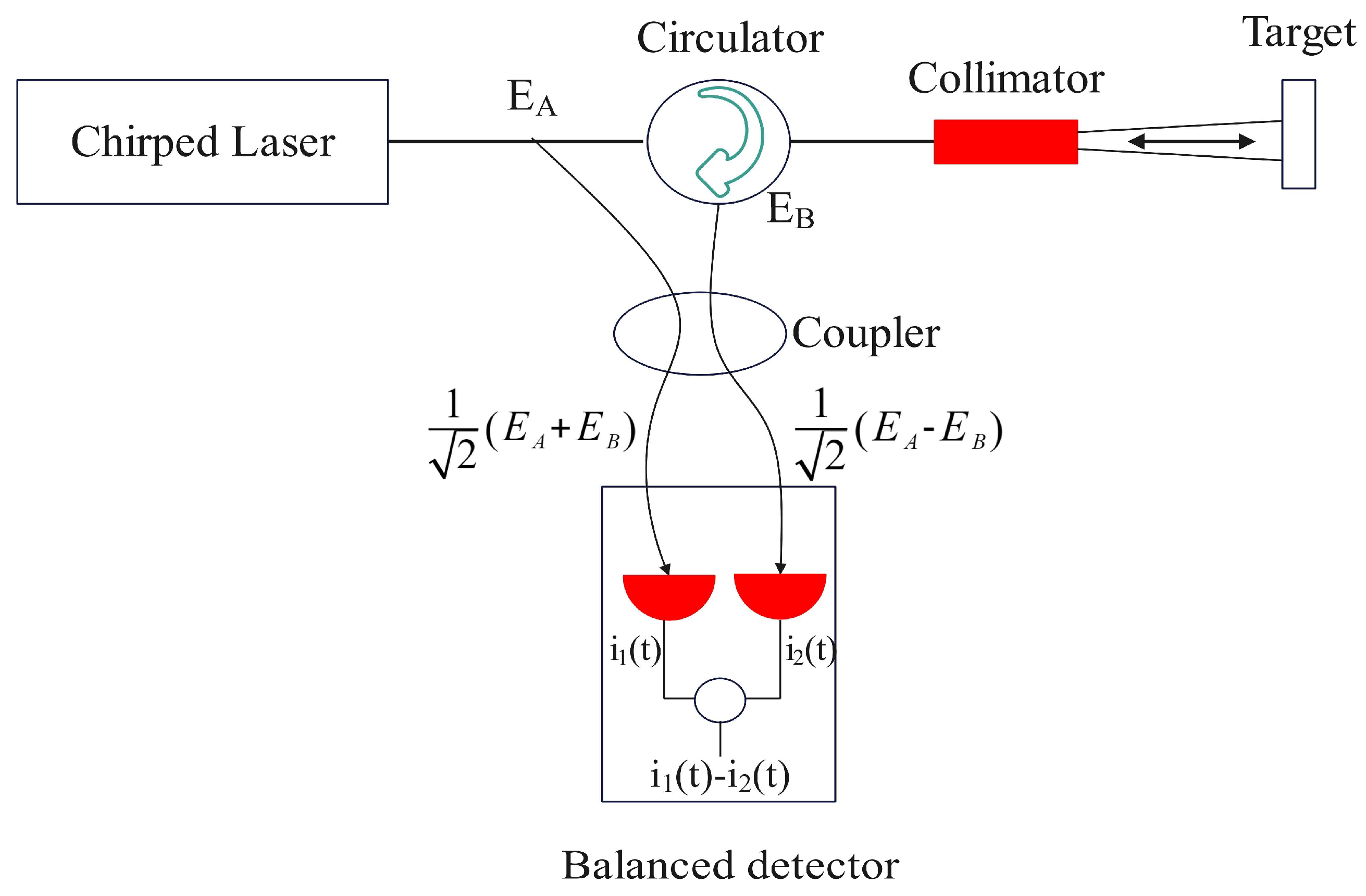

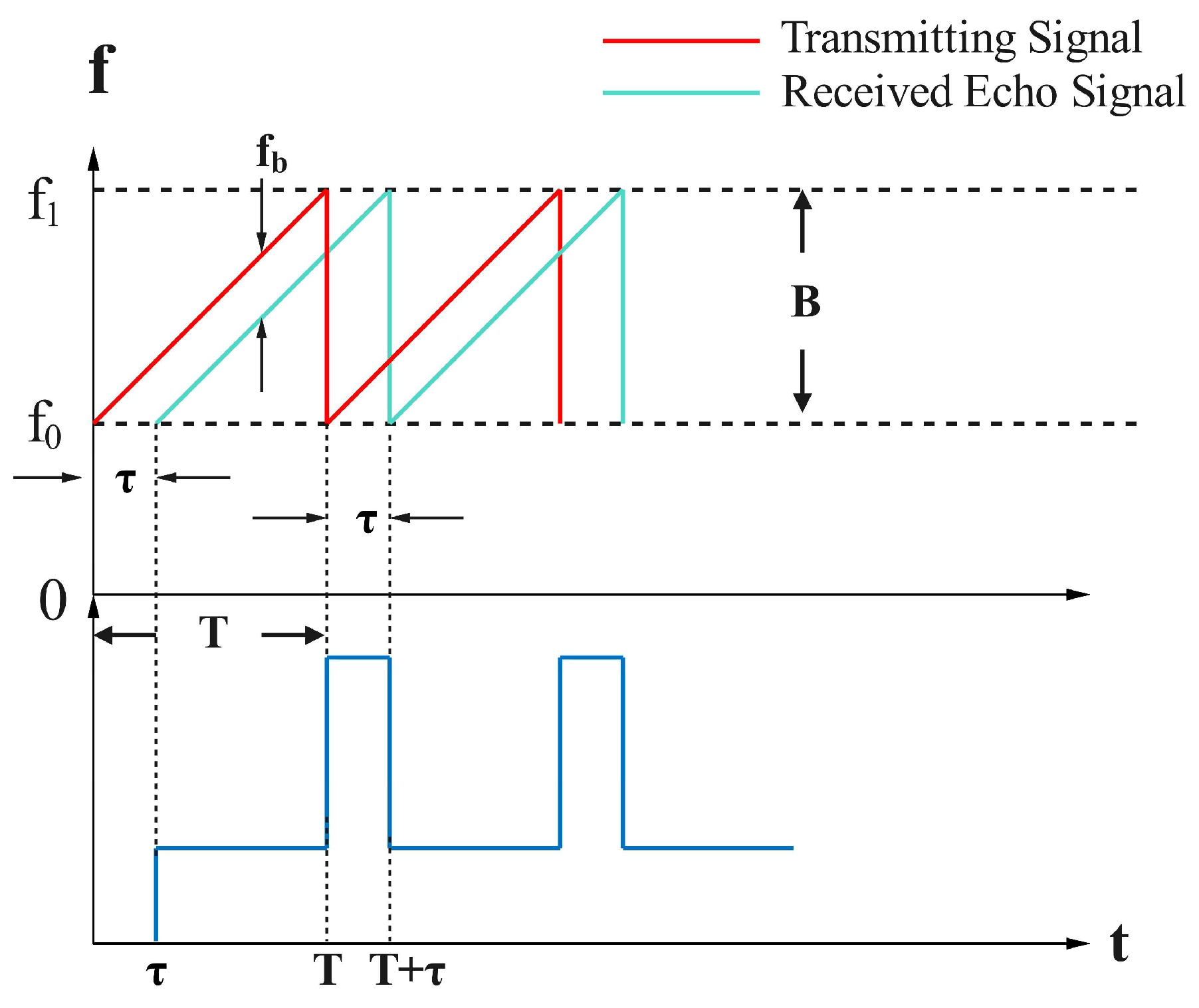

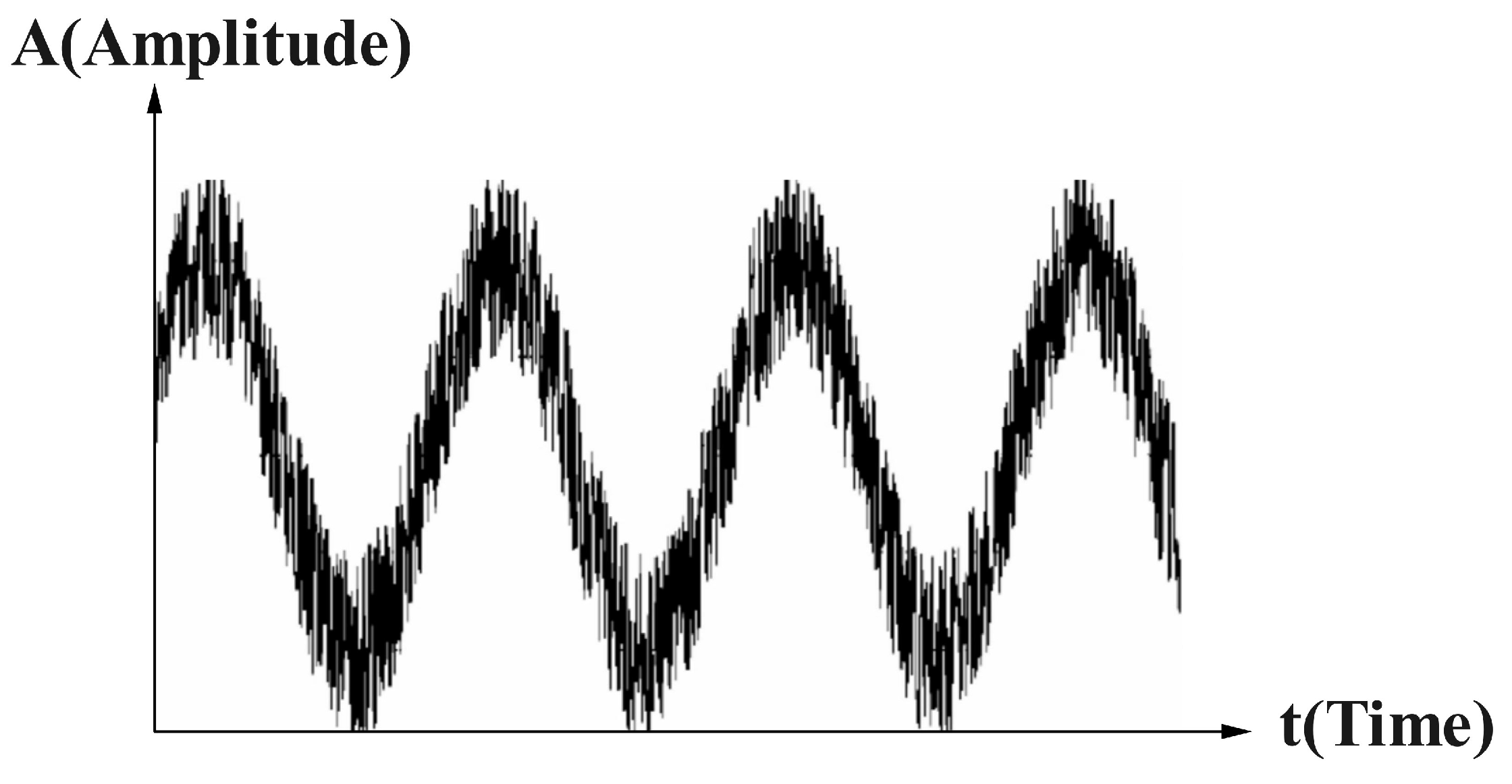
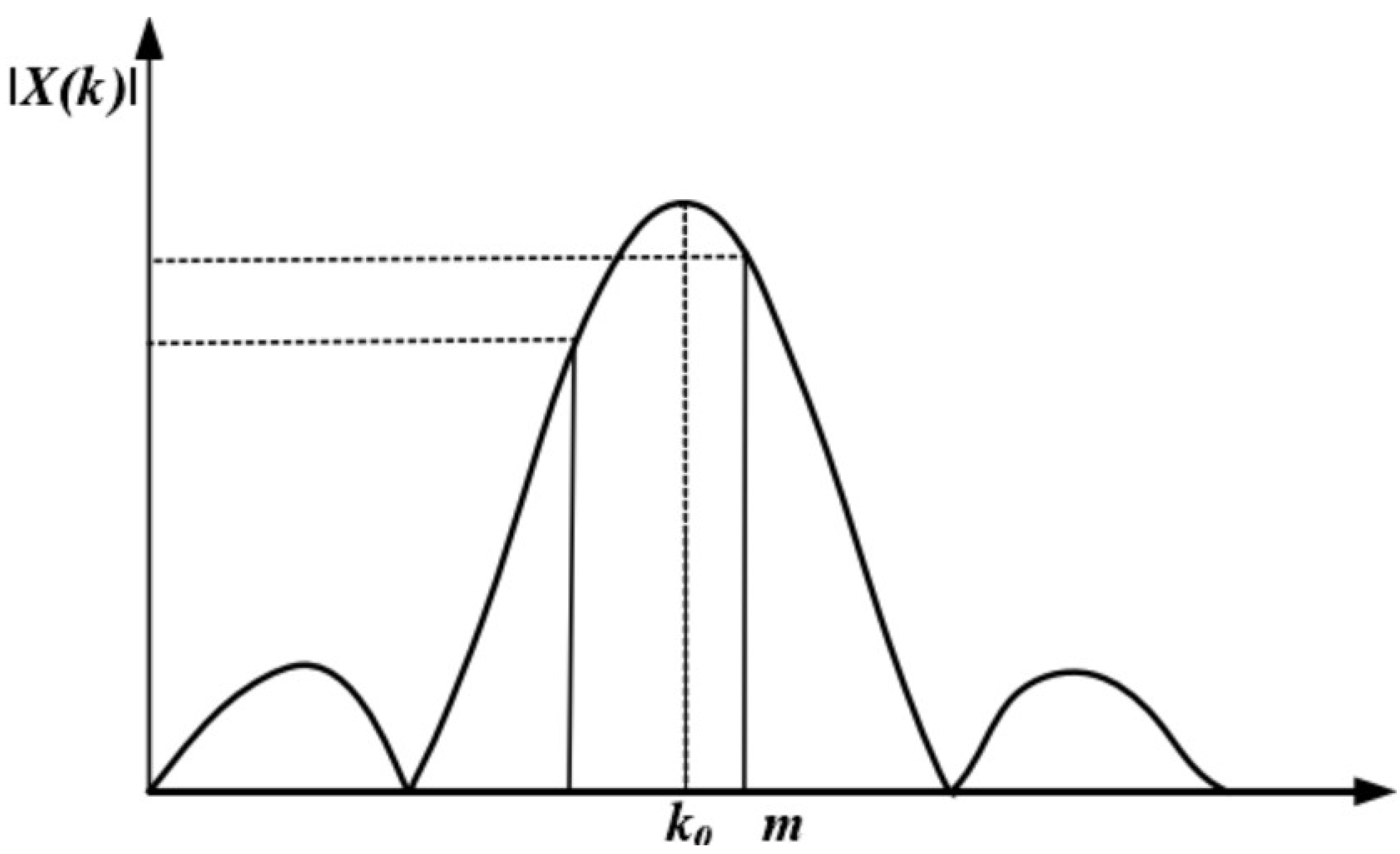
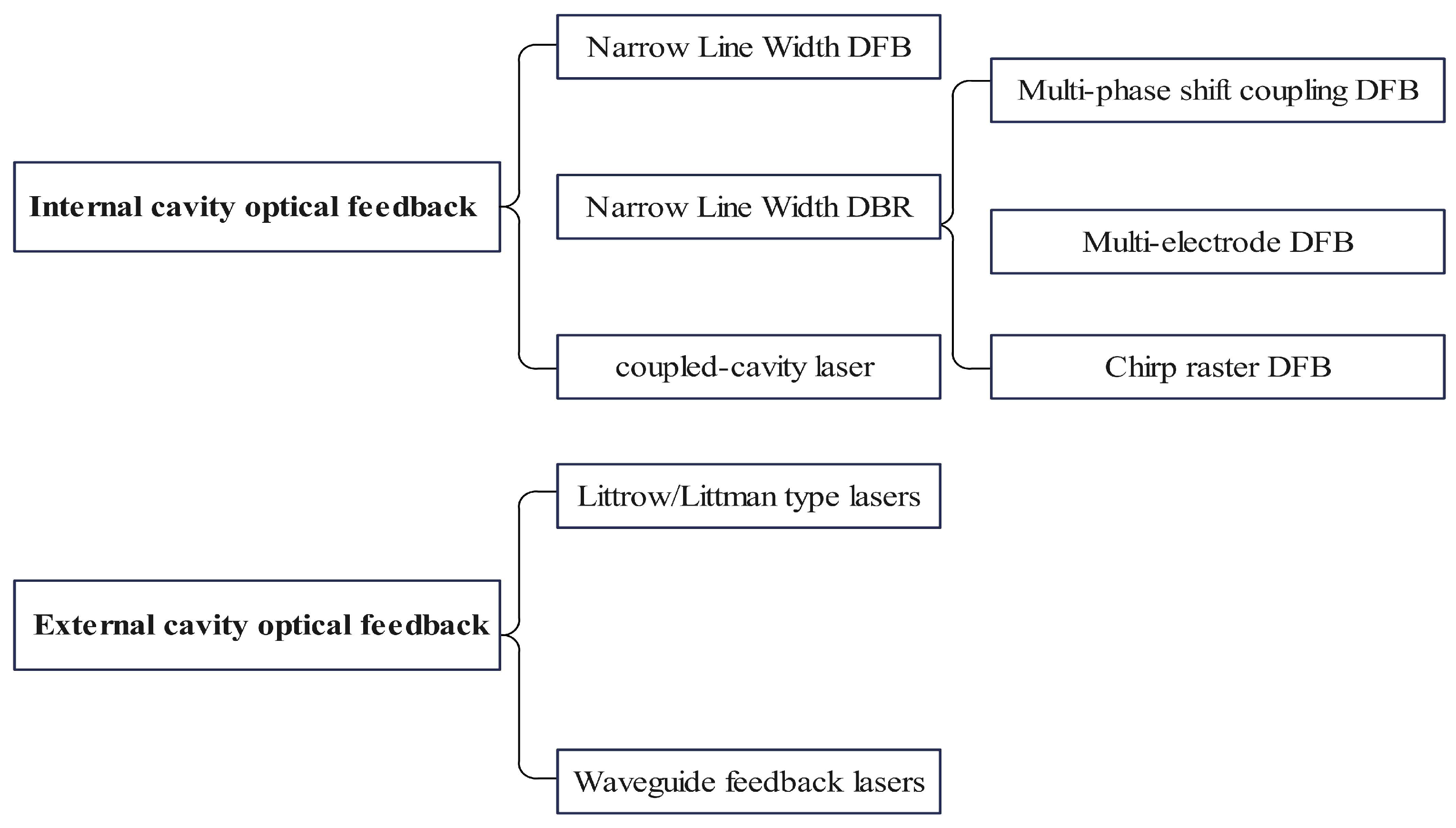



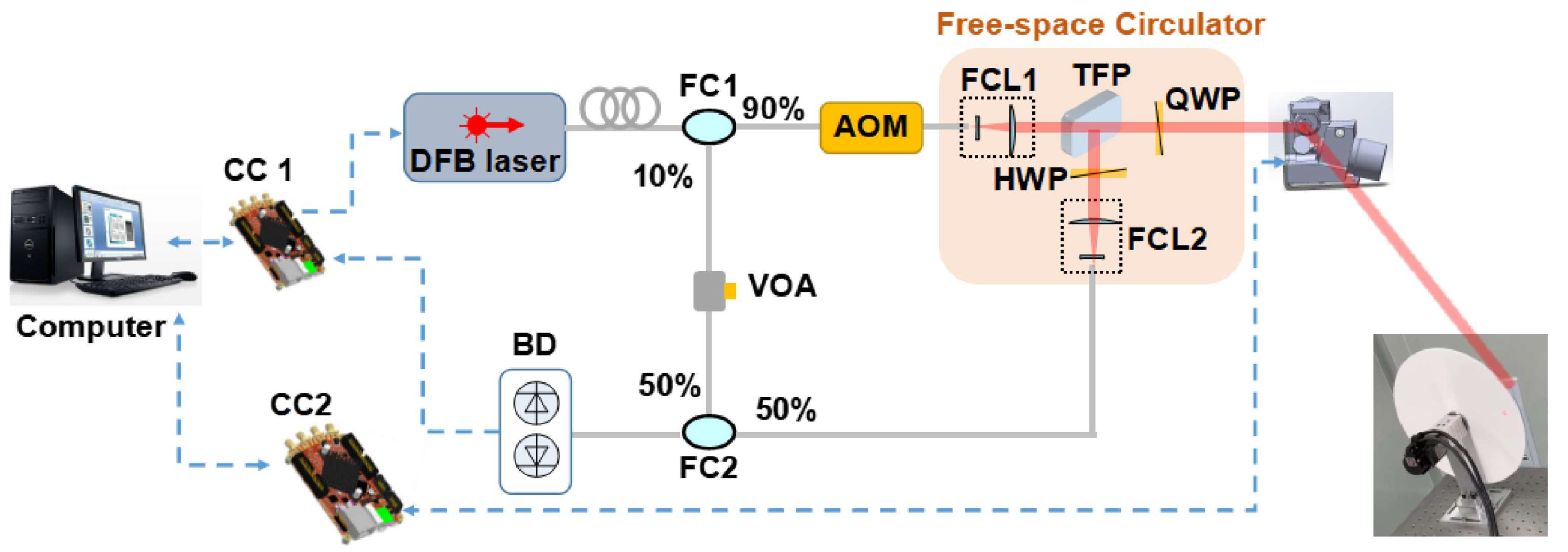
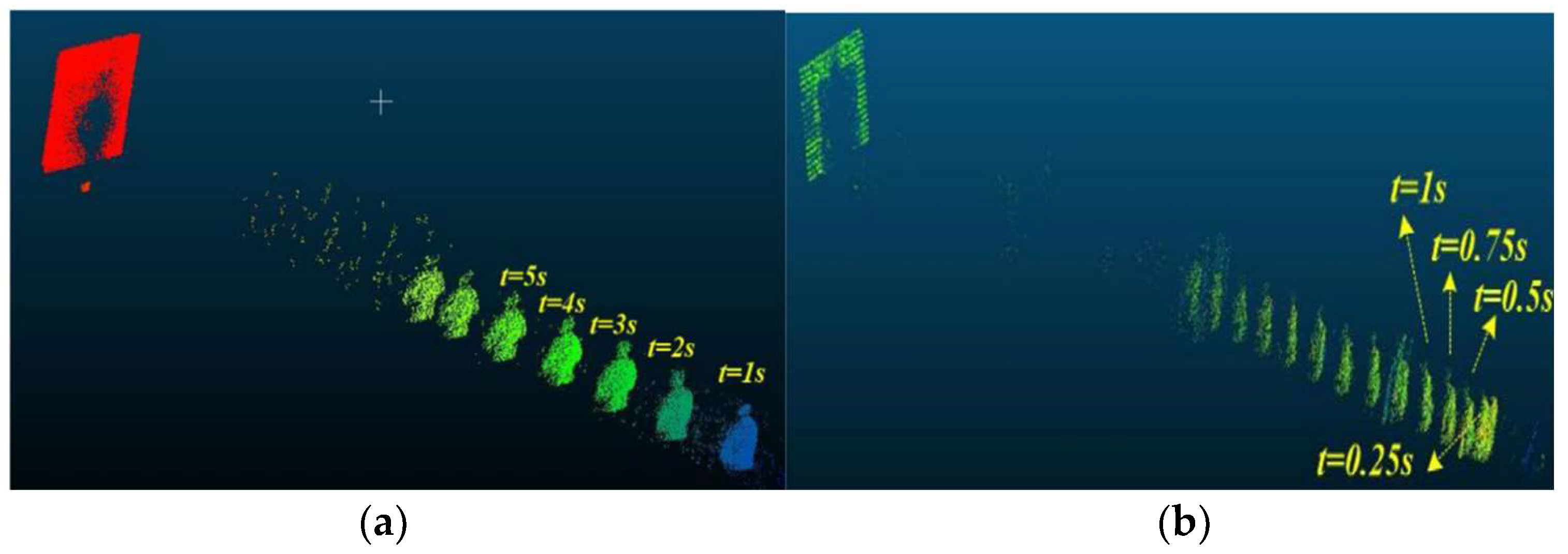
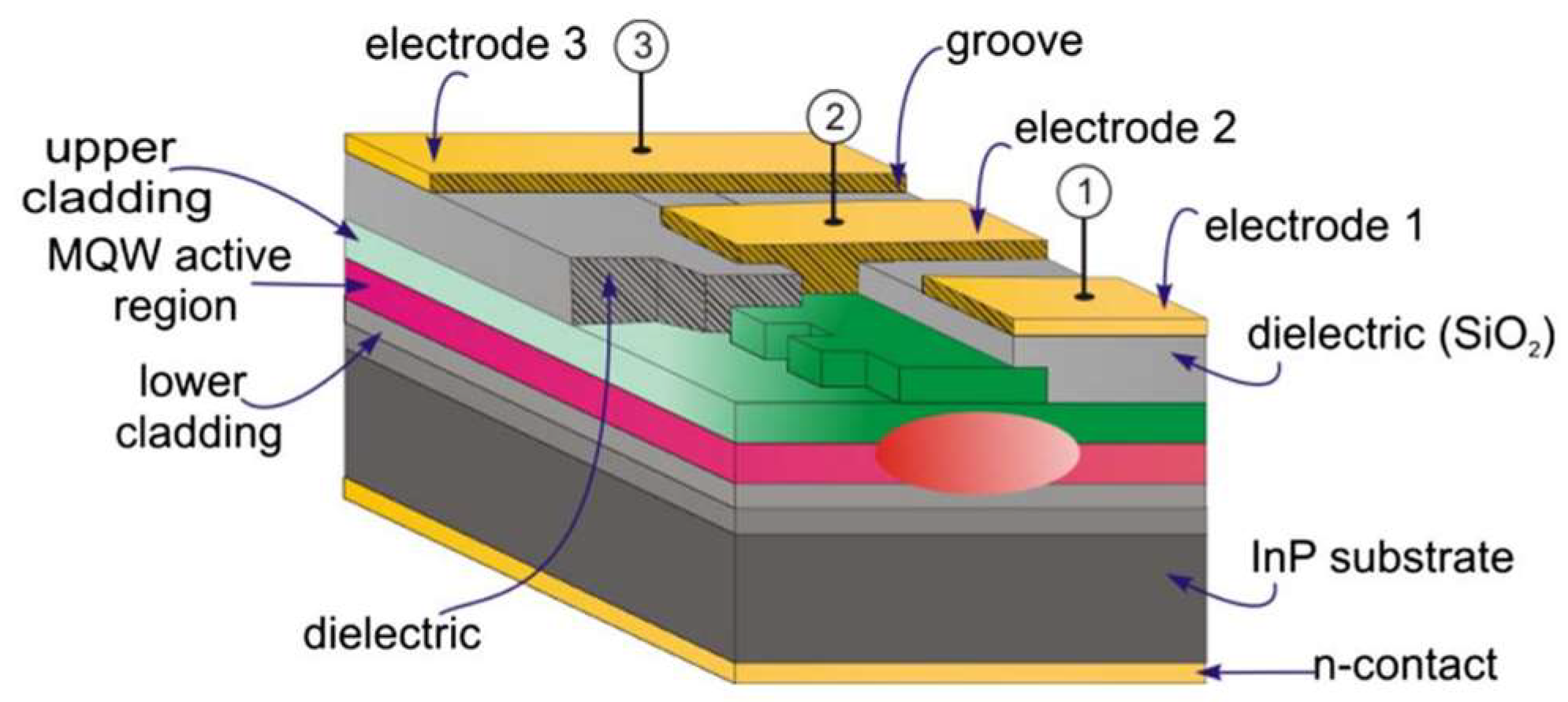
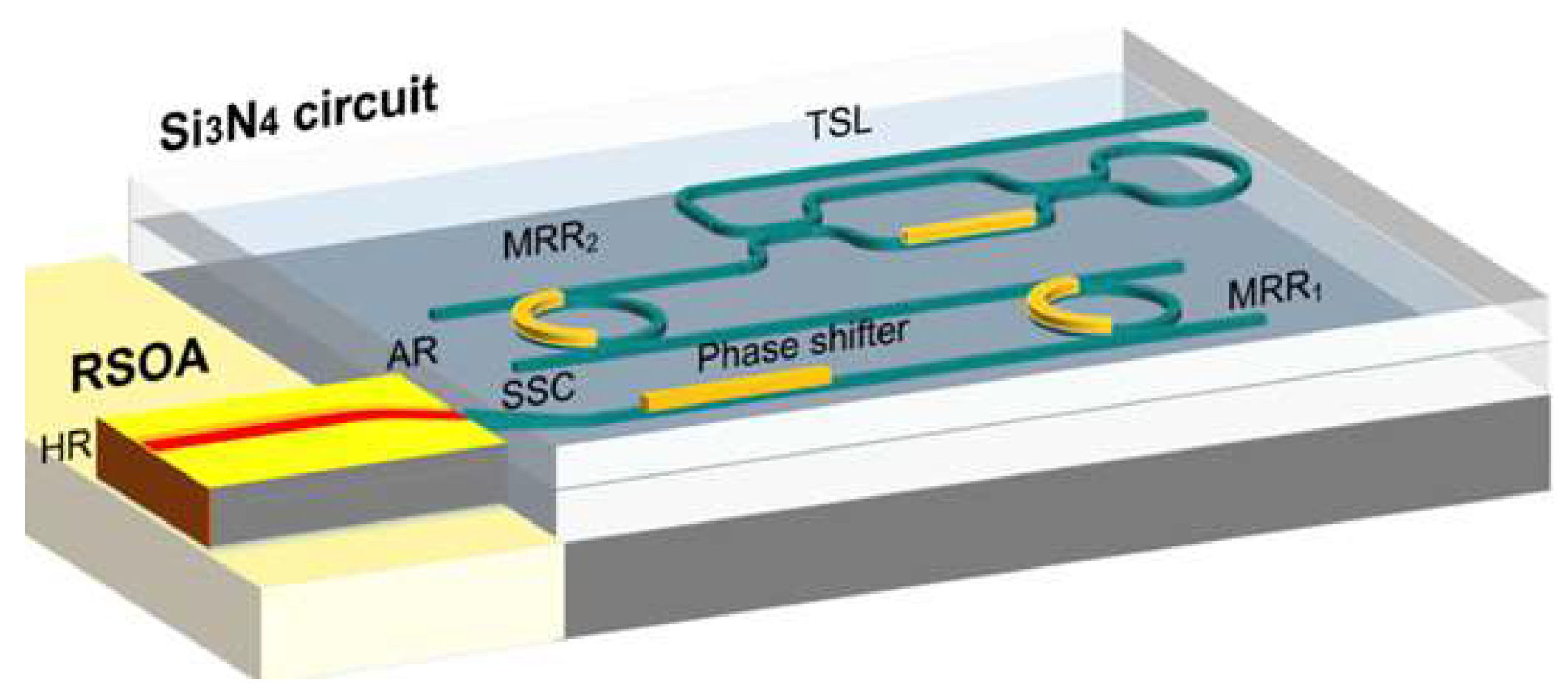
| TOF | FMCW | |
|---|---|---|
| Distance measurement | High precision | Extremely high precision |
| Speed Measurement | Indirect measurement with high latency and low accuracy | Direct measurement with low latency and high accuracy |
| Interference Resistance | Weaker | Strong |
| Signal-to-Noise Ratio | Lower | High |
| Dynamic Range | Narrow | Wide |
| Multi-echo detection | Weaker | Strong |
| Adaptability to Harsh Environments | Weaker | Strong |
| Cost | Low | Short-term costs are high, with significant potential for cost reduction following solid-state integration. |
| Modulation Type | Lasers | Static Linewidth | Dynamic Linewidth Expansion | FM Power Ups and Downs | Maturity and Cost |
|---|---|---|---|---|---|
| Internal cavity optical feedback | DFB | 0.6–5 MHz | Moderate | Severe Fluctuations | Excellence |
| DBR | 200–500 kHz | Poor | Moderate | Complex design, low yield | |
| External cavity optical feedback | External cavity laser | 1 kHz | Excellence | Excellence | Expensive |
| Key Parameters | Factor | Performance Interactive |
|---|---|---|
| Detection distance and accuracy | Coherence length of the transmitted optical signal; sensitivity of the receiver; atmospheric conditions, etc. | Increasing detection range often requires a compromise in detection accuracy, and vice versa |
| Distance resolution and ranging accuracy | Mainly affected by modulation waveform and bandwidth | Wider bandwidth enhances range resolution but may require more complex signal processing techniques to maintain ranging accuracy |
| Angular resolution | Influenced by the aperture of the optical system at the transmitter and receiver, etc. | Improving angular resolution requires reducing the divergence angle and increasing the aperture of its receiving system |
| Random noise | Influenced by internal system components, noise entering the system through the receiver, atmospheric transmission losses, etc. | Improved signal processing algorithms or optimized spectrum analysis techniques |
| FM linearity | Influenced by the stability and quality of the laser light source | Non-linear FM leads to measurement errors |
| Accuracy of distance and angle measurements | Affected by linearity and system calibration of light source frequency modulation | Accurate distance measurement is fundamental to accurate velocity measurement, with both complementing each other |
| Narrow linewidth of light source | Light source quality and stability | Narrow linewidth of the light source improves signal clarity and overall system performance, which, in turn, affects the accuracy of distance and speed measurements |
| Classification | Specific Factors | Description of Performance Degradation |
|---|---|---|
| Time Change | Aging of electronic products | Deterioration in the performance of electronic components, resulting in resistance changes, leakage currents, and other effects |
| Lens degradation | Attenuation and refraction due to lens wear and aging | |
| Mounting vibration | Loose mounting due to long-term effects of vehicle vibration | |
| Pollutant entry | Entry of particles such as dust, water, condensation, etc. | |
| Pixel degradation | Exposure to electromagnetic waves leads to degradation of silicon doping and reduced pixel performance | |
| Employ | Sensor misalignment | Change in sensor position, resulting in a change in the sensor coordinate system relative to the original |
| Vehicle collision | Lens misalignment of the sensor | |
| Hindrance | Light refracted by materials or particles | |
| Vehicle dynamic settings | Changing the sensor coordinates by adjusting the vehicle height | |
| Environment | Extreme temperatures | The sensor operates at conditions other than the appropriate temperature |
| Severe weather | Rain, snow, sleet, frost, fog, etc. | |
| Visual impairment | Copper sheets or windscreen obstructions that block or refract light | |
| Solar | Solar-induced local saturation, lens vignetting, IR-detected color channels |
| Year | Institution | Modulation Type | Lasers | Spectra Linewidth | Ref. |
|---|---|---|---|---|---|
| 2014 | University of Ottawa | Internal cavity optical feedback technology | Multi-electrode surface grating DFB lasers | 140 kHz | [56] |
| 2014 | University of California, Santa Barbara | Narrow-linewidth laser using a slot-coupled cavity | 720 kHz (room temperature) | [57] | |
| 2017 | Tampere University of Technology in Finland | Narrow-linewidth DBR | 250 kHz | [58] | |
| 2021 | Italy | External cavity optical feedback technology | Narrow-linewidth lasers with Littrow Structure | 300 kHz | [59] |
| 2021 | Xi’an Institute of Optics and Precision Mechanics at the Chinese Academy of Sciences | External-cavity narrow linewidth mode-locked semiconductor laser | 5.4 kHz | [60] | |
| 2022 | Shanghai Jiao Tong University | Chip-scale external cavity lasers | 4 kHz | [61] | |
| 2023 | Shanghai Jiao Tong University | Hybrid-integrated tunable external cavity laser | 2.8 kHz | [62] |
Disclaimer/Publisher’s Note: The statements, opinions and data contained in all publications are solely those of the individual author(s) and contributor(s) and not of MDPI and/or the editor(s). MDPI and/or the editor(s) disclaim responsibility for any injury to people or property resulting from any ideas, methods, instructions or products referred to in the content. |
© 2024 by the authors. Licensee MDPI, Basel, Switzerland. This article is an open access article distributed under the terms and conditions of the Creative Commons Attribution (CC BY) license (https://creativecommons.org/licenses/by/4.0/).
Share and Cite
Wu, Z.; Song, Y.; Liu, J.; Chen, Y.; Sha, H.; Shi, M.; Zhang, H.; Qin, L.; Liang, L.; Jia, P.; et al. Advancements in Key Parameters of Frequency-Modulated Continuous-Wave Light Detection and Ranging: A Research Review. Appl. Sci. 2024, 14, 7810. https://doi.org/10.3390/app14177810
Wu Z, Song Y, Liu J, Chen Y, Sha H, Shi M, Zhang H, Qin L, Liang L, Jia P, et al. Advancements in Key Parameters of Frequency-Modulated Continuous-Wave Light Detection and Ranging: A Research Review. Applied Sciences. 2024; 14(17):7810. https://doi.org/10.3390/app14177810
Chicago/Turabian StyleWu, Zibo, Yue Song, Jishun Liu, Yongyi Chen, Hongbo Sha, Mengjie Shi, Hao Zhang, Li Qin, Lei Liang, Peng Jia, and et al. 2024. "Advancements in Key Parameters of Frequency-Modulated Continuous-Wave Light Detection and Ranging: A Research Review" Applied Sciences 14, no. 17: 7810. https://doi.org/10.3390/app14177810
APA StyleWu, Z., Song, Y., Liu, J., Chen, Y., Sha, H., Shi, M., Zhang, H., Qin, L., Liang, L., Jia, P., Qiu, C., Lei, Y., Wang, Y., Ning, Y., Zhang, J., & Wang, L. (2024). Advancements in Key Parameters of Frequency-Modulated Continuous-Wave Light Detection and Ranging: A Research Review. Applied Sciences, 14(17), 7810. https://doi.org/10.3390/app14177810















